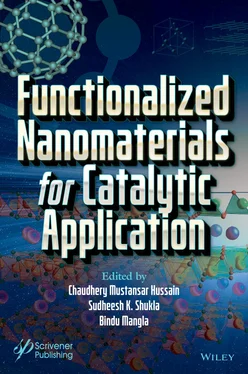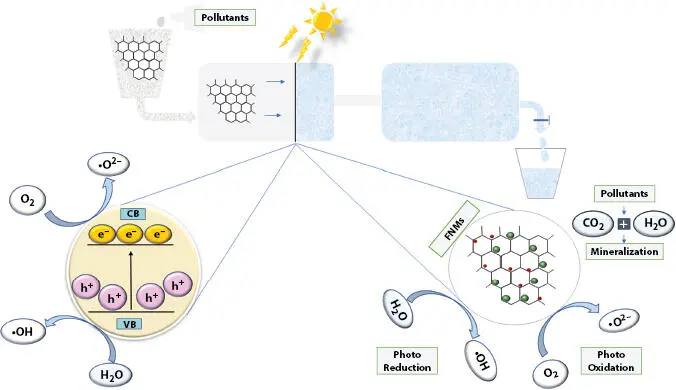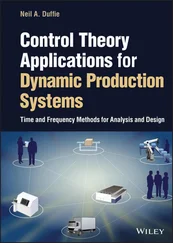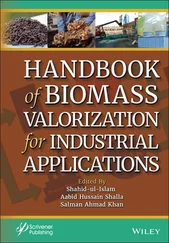The potent essential energy provides vitamins for our present fast-moving lifestyles for easy and quick mobility together with prosperity [111]. Photocatalytic processes aid in conversion of the powerful solar energy to chemical and thus in degradation of unwanted variables [112–114]. Controllable target-oriented reactions of FMNs photocatalysis are productive, yielding positive segments. FMNs’ photocatalytic mechanistic reactions primarily depend upon the interactions between the light energy and the FMNs in question. The interfaces between the valence band (VB) and conduction band (CB) of a specific band energy initiate the utilization of photocatalytic activity for degrading the active toxins [115]. Generally, photocatalytic FMNs belong to a special group of semiconducting materials with a potency to destroy the organic/inorganic/biological pollutants present persistent in filthy water puddles [116, 117].
Significantly, photocatalytic activity pertains to the absorption of photons by the semiconducting material that initiates the photogeneration of energetic negative (e −) electrons and positive (h +) holes between the CB and VB to begin a photo-redox reaction [118, 119]. The band energy gap is either same or more than that semiconducting material and often is on surface of these conducting materials, to generate highly active surface sites required for photocatalysis [120, 121]. A simple operative module is found to be effective for photocatalysis even in low concentration for semiconducting FNMs. Ample literatures are available for the synthesis of FNM PC and their versatile applications in remediation technologies, where the potency depends on methodologies adopted, morphological size, bandgap energy, effective dose, concentration of contaminant, temperature, and pH [122–124]. Reaction kinetics, parametric thermodynamics, and significant reaction mechanism provide a concrete base for further procedures [125, 126].
Authors Bagheri, S. et al . in their review suggested that one of the major setbacks while using UV light as source in heterogenous semiconductor with single carbon derivative as PC can be overcome by FNMs when employed for water treatment [127]. Photocatalytic activity of NMs is deprived due to reconfiguration of photoelectron. Loss of photoelectrons can be reduced by composites and functionalization of NMs (Pd, Pt, Au, Ag, ZnO, ZnSe, ZnS, Cds, SnO 2, TiO 2, and Fe 2O 3) [128]. Other remarkable introductions to conserve the water bodies using PCs as bifurcated units have been pinned up in segments to come. Similar trials have been unfolded in Table 1.3. Photocatalytic action with plausible mechanism is portrayed in Figure 1.5.
| FNMs as catalyst | Year | Scheme |
Process |
Irradiation | |
Parametric expressions |
Probe | Solution evolved | Reusable cycles |
Remarks |
Ref. |
| 3D-Hem/GH | 2017 |
Self-assembly |
Visible light |
pH (3.82–8.99) | (variable) min. |
Rh B | MB | 5 |
Contributors ·O 2−| π - π interaction |
[185] |
| MIL-100(Fe)/PANI | 2020 | Z-Scheme |
Ball-milling |
White light |
pH (2–8) | 120 min |
TC (84%) | Cr (VI) (100%) | 5 |
Attributors ·OH, ·O 2−| π-conjugation |
[186] |
| rGO@ZnO | 2020 |
Facile synthesis |
UV light |
pH (5–9) | 300 min |
OFX | (99%) | 6 |
Reactive ( ·O 2−| ·OH), rGO (−4.42 eV) | ZnO (−4.05 eV) |
[187] |
| Co-MIL-53-NH-BT | 2020 |
Hydrothermal | Step-by-step - assembly |
Visible light | > 400 nm |
pH (2–8) | 120 min |
BPA (99.9%) | OFX (99.8%) |
Activators ·OH + H ++ e −→ H 2O O 2−, ·OH, Co 3+/Co 2+: redox mode |
[188] |
| Pt/g-C 3N 4/Bi 2MoO 6| 2019 |
Hydrothermal |
Visible light |
-| 150 min |
MB (50%) |
VB (2.34V) | CB (-0.86V) Supporters: ·OH, e −, h +, ·O 2− |
[189] |
| Bi-TiO 2NT/graphene NT | 2017 |
Hydrothermal |
Visible light |
-| 60 min |
MB |Herbicide-Dinoseb | 95% |5 |
Contributors ·OH |
[190] |
| Ni/TiO 2| Ru/TiO 2| 2019 | |
Sol-gel | Wet-Impregnation |
Sun light | Visible light |
pH (natural)| 330 min (IMI) | 480 min (ATP, TMX) |
IMI | ATP | TMX | 100% (Insecticides) |
Solar (UV) > visible | Degraded products CO 2| H 2O | ·OH |
[191] |
| ZnO/G/TiO 2(ZGT) | 2016 |
Solvothermal |
Ultrasonic |
pH (9) | 120 min |
MB | TBAC-L | TBBU-L TNFW-L | 4 |
Contributors: ·O 2−, ·OH | π - π interaction |
[192] |
| Zn-TCPP/Ag-TiO 2| 2016 |
Sol-gel |
UV | Visible |
-| 30 min |
MB | PNP | 4 |
Enhancer-Porphyrin | 3.28 eV (bandgap) |
[193] |
| Bi 2S 3/TiO 2-Mt | 2018 |
Ion exchange | Impregnation |
Near UV–Vis-light |
pH (11) | 120 min |
KP (80%) | - |
Langmuir-Hinshelwood | pseudo-1 st-order | ·O 2−| ·OH |
[194] |
| 3D-g-C 3N 4-NS/TiO 2-NF | 2018 |
Electrospinning | Thermal redox |
Visible light >420nm |
- | 120 min |
Rh B (~93%) | 3 |
Activator ·O 2−| pseudo-1 st-order | |
[195] |
| FeNi 3@SiO 2@TiO 2| 2018 |
Sol-gel |
UV-light |
pH (9) | 200 min |
TC (100%) | 5 |
Contributor ·OH |pseudo-1 st-order | |
[196] |
| Co 3O 4/TiO 2/GO/amine | 2017 |
Sol-gel | Hydrothermal |
Solar | Visible light |
- | 90 min | |
OTC (91%) |CR (91%) |5 |
Contributors e ·OH, ·O 2−CB, h + VB, − |
[197] |
| CuInS 2/Bi 2WO 6| 2019 |
Hydrothermal |
Visible light |
| 120 min |
TCH (92.4%) | 4 |
Activators: ·O 2−, ·OH | Z-scheme |
[198] |
| 3D RGO-based hydrogel |
Self-assembly | Reduction |
UV-VIS |
pH (2/3/(acidic) | 120 min |
NPX | IBP | DFC | (70-80%) | |
Langmuir | Freundlich | π-π interaction | pseudo-2 nd-order |
[199] |
| CQDs/TCNCs |
Hydrothermal | Adsorption-polymerization |
Visible light |
pH (basic) | 30 min |
TOC (22%) | CBZ (100 - 87.6%) | 4 |
5 times > pure TCN | Fukui index ( fo = 0.108) olefinic (double bond) |
[200] |
| P M-CQD/TiO 2(M: Ag/Au) |
Green synthesis | Reduction |
UV-VIS (MB) | Solar light (Drug) |
- | 20 min | M: Ag 60 min | M: Au 108 min |
MB (~96%) | Erythromycin (~100%) | Several |
Superoxide ·O 2−, | pseudo-1 st-order |
[201] |
| BiVO 4/N-CQDs/Ag 3PO 4 |
Solvothermal precipitation |
Visible light |
- | 30 min | 90 min |
TC (88.9%) | TOC (59.8%) | 5 |
·O 2−> h +> ·OH | pseudo-1 st-order | pseudo-2 ndorder | Z-scheme |
[202] |
| ZnO/N, S-CQDs | (Capping agent: (Try/Glu)) |
Hydrothermal |
Visible |near-IR | Sun-light |
- | 20–180 min |
MB | RhB | MG | CEL | CIP (92.9%, 85.8%) | 5 |
Activator: ·O 2−|pseudo-1 st-order | |
[203] |
| 3D CQDs/TiO 2/GO - PUF |
Hydrothermal |
Visible light |
- | 1–6 h |
MB | RhB | 5 |
Contributors: ·O 2−, ·OH |
[204] |
| r-Mg-N-CD |
Green Synthesis |
Sun light |
- | 120 min |
MB (99.1%) | 4 |
·O 2−, h +, ·OH | Langmuir Hinshelwood| 1 st- order |
[205] |
| ZnS QD (Capping agent: (L-Cys/2-ME)) |
Sonochemical | Chemical precipitation |
UV light |
11 | 90 min |
CV (98.5%, 97.0%) | 5 |
Langmuir-Hinshelwood | pseudo-1 st-order |
[206] |
| f -MWCNTS-CdS QDs | f -MWCNTS-Ag 2S QDs | (Capping agent - PAMAM) |
Sonochemical | Grafting |
UV |
- | 1h |
MO | - |
Langmuir-Hinshelwood | 1 st-order rate constant |
[207] |
| NH 2-functionalized GQD-TiO 2 |
Molecular fusion | Hydrothermal |
Visible light |
- | 120 min |
MO (96.0%) | 4 |
Contributors: h +(44.7%), ·O 2−(38.0%,), ·OH (17.3%) |
[208] |
| M-ZnS QDs (M: Cu 2+, Mn 2+, Ag +) |
Sono assisted | Chemical precipitation |
UV |
pH (10.5) | 90 min |
VBR (> 95%) | 6 |
Langmuir-Hinshelwood | pseudo-1 st-order |
[209] |
| ZnS: Fe QDs (Capping agent: 2-ME) |
Chemical precipitation |
UV |
pH (8.0) | 90 min |
MG (98%) | 6 |
Langmuir-Hinshelwood | pseudo-1 st-order |
[210] |













